Market OverviewThe LIS market witnessed significant growth in the past few years due to its widespread incorporation amongst laboratories to tackle operational workflow issues associated with regulatory compliance and data security. In addition, the introduction of technologically advanced software solutions that facilitate clinical laboratory workflow management is anticipated to drive demand over the forecast period. For instance, many laboratories incorporate Enterprise Content Management (ECM) software to streamline the processing of sample data delivered to public health organizations.
The market is anticipated to witness growth due to the rising demand for scientific data integration solutions amongst the end-use industries including life sciences, contract research organizations, food & beverage, and chemicals. An increasing need for clinical workflow management in laboratories to improve operational efficiency is expected to propel the growth in the coming years. Furthermore, rising adoption of Laboratory Information Systems (LIS) amongst independent and hospital-based labs to reduce the incidence of diagnostic errors and manage high data volumes is likely to boost the growth of the lab informatics market over the forecast period.In April 2017, Abbott Informatics launched upgraded version of STARLIMS laboratory information management system 11.4 in a probe to gain more market share
Segment OverviewKey components analyzed in the laboratory information systems vertical are software and services. The services segment held the dominant share in 2015 and is expected to exhibit a sturdy growth rate in the future. On the other hand, the software segment is anticipated to exhibit growth owing to the introduction of technologically advanced software solutions, such as SaaS, which has revolutionized LIS.
The life sciences industry was the largest end-use segment and accounted for a share in 2018. Increasing advances in the healthcare industry due to rising R&D activities in the field of medical research is anticipated to fuel the demand for laboratory information systems in the coming years. Increasing incorporation of LIS, particularly in research & hospital labs, because of its growing application scope, including patient engagement, patient health information tracking, workflow management, billing, and quality assurance at hospitals, labs, and other life science companies, is expected to propel the laboratory informatics market growth. The CRO segment is anticipated to grow lucratively over the forecast period due to the increasing outsourcing trend in the pharmaceutical & biotech industries
Regional OverviewGeographically, the market has been segmented into four major economies including North America, Europe, Asia-Pacific, and LAMEA. North America consists of US, Canada, and the Rest of North America. Europe comprises of the major countries including the UK, Germany, France, Italy, Spain and the Rest of Europe. Similarly, Asia Pacific consists of major countries such as, Japan, China, India, South Korea, Australia and, the Rest of Asia Pacific. LAMEA consists of Brazil, Saudi Arabia, UAE, and the Rest of LAMEA.
North America region accounted for the major market share in 2018. The presence of established pharmaceutical companies and research labs coupled with higher awareness levels of LIS amongst the end-users is expected to drive the demand. Furthermore, increasing R&D activities in the biotech &pharmaceutical industry and the existence of stringent regulatory compliance requirements is expected to fuel the growth of this vertical during the forecast period. Asia pacific is emerging as an outsourcing hub for the laboratory informatics market due to its surging demand amongst the pharmaceutical manufacturers. Manufacturers outsource LIS activities to improve operational efficiency and reduce the cost of LIS support systems. The presence of numerous CROs in the fast-growing economies, such as Iran & China, is anticipated to boost the demand.
Competitor overviewSome of the key market participants include LabWare, Thermo Fisher Scientific, Inc., Core Informatics, LabVantage Solutions, Inc., PerkinElmer Inc., LabLynx, Inc., Abbott Laboratories, Agilent Technologies, IDBS, Waters, McKesson Corporation, and Cerner Corporation. Technologically advanced platforms offered by the industry players, such as SaaS for smaller organizations, are anticipated to boost the adoption of LIS. In March 2017, Thermo Fisher Scientific acquired Core Informatics in an attempt to significantly enhance Thermo Fisher’s existing informatics solutions
Key Players
- Thermo Fisher Scientific, Inc
- Epic
- Sunquest
- LabWare
- Core Informatics
- Abbott Laboratories
- LabVantage Solutions Inc.
- LabLynx, Inc
- PerkinElmer, Inc.
- Waters
- Agilent Technologies
Market Segmentation
By Product
- Laboratory Information Management Systems (LIMS)
- Electronic Lab Notebooks (ELN)
- Scientific Data Management Systems
- Laboratory Execution Systems
- Electronic Data Capture & Clinical Data Management Systems
- Chromatography Data Systems
- Enterprise Content Management
By Component
- Software
- Services
- By Delivery Mode
- On-premise
- Web Hosted
- Cloud Based
By End Use
- Laboratories
- Healthcare CROs
- Pharmaceutical Companies & Related R&D Labs
By Geography
- North America
- Europe
- UK
- Germany
- France
- Italy
- Spain
- Rest of Europe
- Asia-Pacific
- Japan
- China
- India
- Australia
- South Korea
- Rest of Asia-Pacific
- LAMEA
- Brazil
- Saudi Arabia
- UAE
- Rest of LAMEA
Research Process
Data Library Research are conducted by industry experts who offer insight on
industry structure, market segmentations technology assessment and competitive landscape (CL), and penetration, as well as on emerging trends. Their analysis is based on primary interviews (~ 80%) and secondary research (~ 20%) as well as years of professional expertise in their respective industries. Adding to this, by analysing historical trends and current market positions, our analysts predict where the market will be headed for the next five years. Furthermore, the varying trends of segment & categories geographically presented are also studied and the estimated based on the primary & secondary research.
In this particular report from the supply side Data Library Research has conducted primary surveys (interviews) with the key level executives (VP, CEO’s, Marketing Director, Business Development Manager
and SOFT) of the companies that active & prominent as well as the midsized organization
FIGURE 1: DLR RESEARH PROCESS

Primary Research
Extensive primary research was conducted to gain a deeper insight of the market and industry performance. The analysis is based on both primary and secondary research as well as years of professional expertise in the respective industries.
In addition to analysing current and historical trends, our analysts predict where the market is headed over the next five years.
It varies by segment for these categories geographically presented in the list of market tables. Speaking about this particular report we have conducted primary surveys (interviews) with the key level executives (VP, CEO’s, Marketing Director, Business Development Manager and many more) of the major players active in the market.
Secondary Research
Secondary research was mainly used to collect and identify information useful for the extensive, technical, market-oriented, and Friend’s study of the Global Extra Neutral Alcohol. It was also used to obtain key information about major players, market classification and segmentation according to the industry trends, geographical markets, and developments related to the market and technology perspectives. For this study, analysts have gathered information from various credible sources, such as annual reports, sec filings, journals, white papers, SOFT presentations, and company web sites.
Market Size Estimation
Both, top-down and bottom-up approaches were used to estimate and validate the size of the Global market and to estimate the size of various other dependent submarkets in the overall Extra Neutral Alcohol. The key players in the market were identified through secondary research and their market contributions in the respective geographies were determined through primary and secondary research.
Forecast Model


